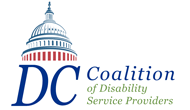How NCC responded to COVID with Accessibility and Inclusivity
For this Friday’s installment, we spoke to Patricia Browne, President and CEO of The National Children’s Center (NCC) on how they responded to the unforeseen challenges of COVID-19 pandemic.
After setting up a task force in February, NCC began developing a manual on how to prepare for the pandemic. On March 17th, all operations besides those of the essential workers (Direct Support Staff and Nurses) went fully virtual and they remain virtual today. NCC’s first major hurdle arose in trying to acquire personal protective equipment (“PPE”). “That was incredibly frustrating. There was no one who was making it readily available to us,” Browne explained. Amazon was declining their orders as I/DD DSPs were not considered essential health workers, and contacting PPE manufacturers directly also proved unfruitful, as they would only accept large orders in counts of hundreds of thousands. In the meantime, NCC harnessed the power of their community, finding volunteers to make cloth masks for their essential workers. “Finally someone was willing to carve off a piece of someone else’s order to sell to us, so that really started our rhythm of distributing the PPEs,” said Browne.
NCC soon realized that conventional face masks would not be sufficient for all members of their community. As Steve Holley, a DSP at NCC described in an NBC local broadcast story, “[T]he thing about these face mask protocols is that they can become a barrier for deaf people. When they pull the face masks down to talk, we are less safe.” The clear face masks didn’t allow for lip-reading, so they recruited a volunteer to make clear face masks with cotton and vinyl. NCC found that these masks proved vital not only for deaf adults and their in-home staff, but also for those who teach infants and one-year-olds in early intervention programs in the District. As Browne described, “We also understand that small children start learning language skills by watching your mouth. Those teachers need clear masks, because the children needed to see their lips.” Implementing the clear masks helped NCC foster better communication for everyone they support during this turbulent time.
Though clear masks are an important step towards inclusivity, NCC understands that these masks are not a perfect solution either. As Paulo Martell, an NCC program coordinator and fellow member of the deaf community stated in a story for Yahoo Life, “Even an expert lip reader still can only catch half or less of what this person is saying.” Moving towards the future, NCC is looking to implement more ASL education for the hearing staff, as it’s a safer form of communication than spoken language. As Martell describes, “A droplet of fluid from our mouth while speaking can travel from one person to other person and sign language doesn’t, therefore it’s a safer [way] to communicate via sign language than it is to speak.” Learning ASL and developing clear masks are just a couple of the new responses NCC has implemented throughout this pandemic to better engage the people they support. Browne stated, “We are looking at all new ways to keep people engaged, keep them safe, and to leverage technology… Why should they [the deaf community] have to accommodate us all the time? We need to meet them where they are as well.”
